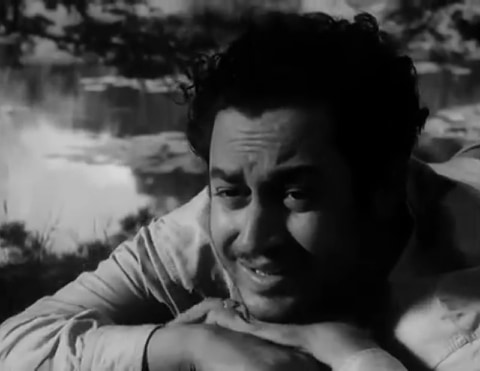
Main Doon Bhi To Kya Doon Tumhein, Ae Shokh Nazaaron: Guru Dutt in Pyaasa (1957)
As a writer, I too have dreams of getting published and become popular and known to everyone. It’s a long journey and sometimes rejections hurt so much that nothing feels right. But even then, I know that I have to keep going on and have conviction and faith in my art, in the stories and poems that I write.
Vijay too was facing multiple rejections. He too had extreme conviction to go on and had faith in his poems. But with him, the tragedy was that his own people, his own society never trusted him. This constant rejection and the loss of his loved ones in his life led him to drinking and the amount of greed and disloyalty that he sees in the society sets the story of the phenomenal Pyaasa.
Pyaasa was produced and directed by Guru Dutt, who also played the lead role of a talented but struggling poet Vijay. Written by Dutt’s close aide Abrar Alvi, the film also stars Mala Sinha, Waheeda Rehman, Rehman and Johnny Walker in supporting roles. Pyaasa was both critically and commercially successful and it emerged like a textbook on filmmaking for generations to come.
Guru Dutt’s magnum opus was obviously not created without obstacles or say, changes. Pyaasa was originally titled ‘Pyaas’, hinting at the thirst for fame and success in Vijay. It was suggested by Alvi. But Guru Dutt didn’t like this title as he was of the view that Pyaasa would be more appropriate, hinting more at the character. Hence, the title was Pyaasa. Guru Dutt had the tone for the story set in his mind. He had this story for a long time. It is said that the character of Vijay is based on the film’s writer Abrar Alvi’s life only. Even Waheeda’s character Gulab was based on a real-life prostitute of the same name whom Abrar had met in his life. Guru Dutt had certain rhythms set in his mind for the film which would look great with the usage of some brilliant poetry. Thus, Abrar suggested him to show Vijay as a poet, not as a writer as it was initially in Dutt’s mind. The idea worked! Pyaasa has some extraordinary poetry by none other than Sahir Ludhianvi that decorated the film with beautiful words and verses, making the film a poetry on celluloid. But we will talk about it later.
The film starts with Vijay (Guru Dutt) laying on the grass, admiring the nature around him as the lines go “Ye Hanste Hue Phool, Ye Mehka Hua Gulshan…” in the melodious voice of Mohammad Rafi. The camera focuses on a bumblebee wandering over a flower – a beautiful symbolism showcasing the ‘thirst’ of both the bumblebee and Vijay. Vijay is admiring the insect with a smile on his face. Next, we see the bee under the feet of the passer-by, dead. Now, the thing to notice here is that the feet that tramples the bee isn’t any ordinary feet, but a feet of some elite person as we see it is covered with a polished black shoe. Vijay is sad at this sight. He gets up and leaves with his coat on his shoulder, as if thinking he has nothing to offer to the Mother Nature as the last lines go “Main Doon Bhi To Kya Doon Tumhein Ae Shokh Nazaaron, Le De Ke Mere Paas, Kuch Aansoo Hain Kuch Aahein.” This first scene actually gives us the gist of the entire plot of Pyaasa – a poet is thirsty for fame and success, but he, alongwith his dream, is crushed by those much above him in the society that only worships greed, money and materialistic pleasures.
Cut to next scene, where we see a hopeful Vijay entering a publishing house to know the status of his poems. He is told that his poems are rubbish and so they aren’t publishing it. Vijay is furious. His anger increases even more as he finds his poems in the dustbin. He is asked whether he has ever read Mir and Momin to which he replies. “Ji haan! Aur Josh aur Faiz ko bhi!” We come to know the kind of poet that he is – who writes about hunger, poverty and employment rather than just romantic verses.
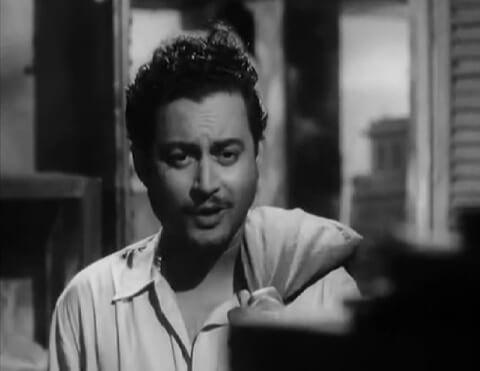
Ji haan! Aur Josh aur Faiz ko bhi!: Guru dutt portrayed the character of Vijay with finesse.
From here, we are entered into the struggles of Vijay. His world is melancholic and his heart is broken. He has no family as his brothers have thrown him out of the house for being ‘good-for-nothing’. Played by Mehmood and Radheshyam, the elements of greed were so instilled in their characters that I almost hated them. Mehmood was a big surprise though, as he is renowned as a comedian. These brothers also sell Vijay’s poems as waste papers for ten annas. It is only Vijay’s mother/’maa’, played to perfection by the veteran Leela Misra, who keeps showering her love on her youngest son. Vijay promises to take her away once he has found a new home. But he is unable to do so and it shocks him when he comes to know of his mother’s demise through his brothers at the ghat.
But Vijay was not the same before. He was cheerful who wooed his love interest Meena (Mala Sinha) through his poem. Alongwith Waheeda, Mala Sinha was also a fresh actress that time. She was honest in her portrayal of Meena, a woman who loved Vijay but later left him and married a publisher named Mr. Ghosh (Rehman) as being a practical woman, she tells Vijay in one of the scenes, “Har samajhdaar aurat ko zindagi mein pyaar ke alaava ghar-o-baar ki bhi zaroorat hoti hai, thodi bahot daulat ke sahaare ki bhi zaroorat hoti hai…” Whether she did the right thing or not is up to you to decide, but her love for Vijay can’t be questioned. Maybe, it can be. Vijay accuses her of selling her love for comfort and luxury as he says in the same scene, “…Mr. Ghosh se byaah kiya. Yaani daulat ke liye tumne apna pyaar bech diya.” The pain is there. The anger is there. The frustration is there. But Vijay is over it. He has learnt to be happy on his own (“Main apni khushi aap haasil karna seekh gaya hoon”).
It was Gulab who understood Vijay the way he should have been understood by everyone. Gulab’s tender heart couldn’t help falling for a struggling poet Vijay who has nothing to give to her. But Gulab’s love for Vijay is not ordinary. It doesn’t demand anything and have zero expectations. She begins worshipping the poet after falling in love with his poetry, understanding the kind of a person Vijay is. In a world where elites and ‘educated’ are expected to be sane and cultured, it was a prostitute with a heart of gold who became the support of Vijay. Waheeda Rehman played her character with delicate expressions and brilliance.
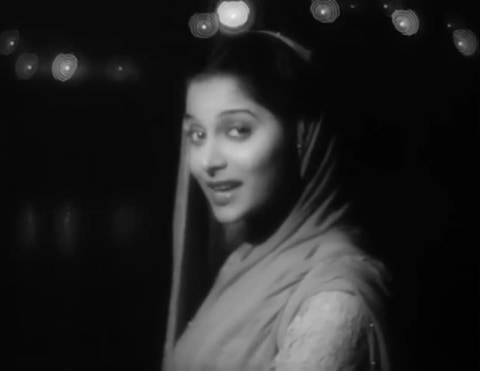
Jaane Kya Tune Kahi!: Waheeda Rehman gracing the screen as Gulab.
What’s amazing is the kind of dialogues that this film has. Abrar Alvi, who had fine knowledge of Hindi, Urdu and English, whose sharp ear for film dialogue caught Guru Dutt’s attention with whom he collaborated till the former’s tragic death on 10th October, 1964, has written such wonderful and thought provoking dialogues that they keep ringing in one’s ears from time to time. Pyaasa’s dialogues, apart from its songs, also commented on the greedy and selfish nature of the humans and the society in general.
The scene in a lift where Meena and Vijay’s encounter takes place years after the former’s marriage, Meena asks Vijay’s well-being and his whereabouts. They’re still talking when the lift stops and its gate slides open, making a noise that distracts both of them. It is then that Meena says, “Main to bhool gayi. Mujhe to upar pahunchna tha.” This dialogue clearly hints at the desire of Meena. She wanted to go up. She wanted a life of respect, comfort and luxury. Vijay just looks at her and then gets out of the lift along with a few others. Meena is all alone now. In the next shot, the camera focuses on Meena as she is crying. The lift is closed again as Meena comes forward, and then it goes up with her. She is now trapped in her own world.
Vijay’s disrespect by the society and its careless attitude towards his poems is also seen in various other scenes of the film. Before the song Jaane Wo Kaise Log The, we see that Vijay was ‘invited’ by Mr. Ghosh to the party. Here, he is made to serve the drinks in front of his estranged lover. But before that, right in the first shot of this ‘party scene’ we see Mr. Ghosh talking to a female guest and asking her the reason for her husband’s absence. The lady replies, “Arre unhein kaafi tez dard hone laga to unhone mujhse kaha ki mujhe hospital le chalo. Par maine bhi ye kehke taal diya ki apne pati ko hospital pahunchaane ke liye main itni badi party kaise miss kar sakti hoon?” This dialogue by Abrar clearly hints at the materialistic pursuits of the rich and elite society who have no value for relationships and emotions. Vijay falls prey to this very attitude. Just after the song Jaane Wo Kaise Log The, a guest starts praising Vijay by saying “Bhai waah bahot khoob! Subhan Allah, Subh…” but then he stops as he notices that he is the only one doing so. After that, people resume their conversations again, not giving heed to Vijay. Personally for me, this is the most heartbreaking scene of the film.
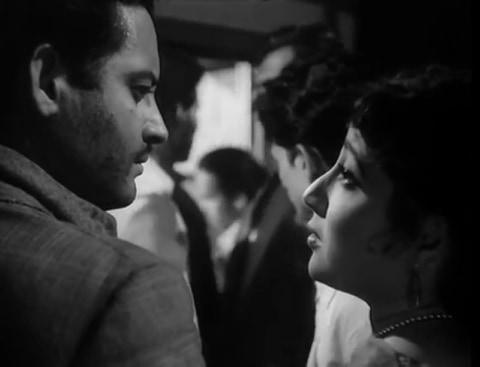
Main to bhool gayi, mujhe to upar pahunchna tha: Mala Sinha as Meena with Guru Dutt.
The world is greedy and worships just the wealth around. Vijay learns this thing and by the end he denounces the world (Ye Duniya Agar Mil Bhi Jaaye To Kya Hai), leaves everything behind and goes with Gulab to start afresh.
There is also a scene in the end which, according to me, can be the sum up of the entire film, or maybe about Guru Dutt’s own philosophy.
Vijay finally comes back in the auditorium only to announce that he is ‘not’ Vijay. The crowd there gets angry and throws slippers at him and even tear down his cloth. He is somehow taken backstage where in a room, Meena asks him why he took such a step, to which he replies:
“Mujhe inse koi shikaayat nahin hai. Mujhe kisi insaan se koi shikaayat nahin hai. Mujhe shikaayat hai samaaj ke us dhaanche se, jo insaan se uski insaaniyat chheen leta hai. Matlab ke liye apne bhai ko begaana banaata hai. Dost ko dushman banaata hai. Mujhe shikaayat hai us tehzeeb se, us sanskriti se, jahaan murdon ko pooja jaata hai aur zinda insaan ko pairon tale raunda jaata hai. Jahaan kisi ke dukh-dard pe do aansoo bahaana bujhdili samjha jaata hai, jhuk ke milna ek kamzori samjha jaata hai. Aise mahaul mein mujhe kabhi shaanti nahin milegi Meena, kabhi shaanti nahin milegi. Isiliye main door jaa raha hoon.”
Vijay is portrayed as some kind of an ascetic in this scene as the light emerges from behind him, making him look like a spiritual body who has left everything to live in the world of isolation. Guru Dutt again makes perfect use of light in this scene which doesn’t fail in putting the character in the center, in fact idolizing him to the extent that he looks like some God.
In Pyaasa, poetry is a leitmotif in the main plot. It is the only thing that connects three main characters of the film. This poetry is quite visible and on its prime in the songs written by the wordsmith Sahir Ludhianvi.
TALKING ‘TECHNICALLY’
Having made hits like Baazi (1951), Jaal (1952), Aar-Paar (1954) and Mr. and Mrs. ’55 (1955), Guru Dutt had established himself as an accomplished filmmaker. He had become popular by the time the idea of Pyaasa was lingering in his mind. Now, he wanted to make the kind of films that he liked and Pyaasa was the first one.
As discussed earlier, Guru Dutt wanted this to be the story of a writer. But after listening to Abrar’s suggestion, the writer was replaced by a poet. Guru Dutt, who was good both behind the camera and in front of the camera, decided to tell this heartbreaking tale of a poet who has been abandoned by the society and his love by playing the character of Vijay himself and taking command of the entire project as producer and director.
The shots in Pyaasa are brilliant, matching the emotions of the characters. Guru Dutt’s style of filmmaking is something which was quite new at that time. It’s because of his detailed sight on the story that Pyaasa is still remembered today among all cinema-goers. Merging art house cinema into commercial cinema, Dutt surprised everyone by showing them how you can entertain and also raise important issues at the same time. His way of storytelling was unique and though the plot was melodramatic, it doesn’t fall in the lazy, time pass drama category as Pyaasa was in the safe hands of an auteur like Guru Dutt.
Often termed as India’s Orson Welles, Guru Dutt’s avant garde works were already seen by many before Pyaasa was released. But people were yet to know what he was capable of achieving. Dutt’s style of filmmaking is also remarkable as he was known for infusing songs into the narrative. The songs in Dutt’s films always help the narrative in moving forward, thus being one of the essential parts of the plot. Guru Dutt’s dedication was unmatched and it shows in all his works before Pyaasa as well. The thirst for more gave birth to Pyaasa later which became the man’s magnum opus, followed by Kaaghaz Ke Phool (1959).
This article would be incomplete without the honourable mention of one-timed violinist and a jailed freedom fighter V.K. Murthy, whose cinematography in Pyaasa is so detailed and structured that one can never forget its beautiful frames. Murthy uses stark contrast in shots which perfectly define the melancholy of the protagonist and also the reality of the hypocritical society. The classic image of Vijay being “resurrected” in the end after he is presumed dead is the haunting yet beautiful image which stays in viewer’s mind for the long time. The slow but effective camera movement in the song Ye Duniya Agar Mil Bhi Jaaye To Kya Hai calmly fulfils its responsibility of capturing all the main characters from slightly low angles one-by-one, standing against whom is the mighty Jesus Christ like figure whose close up shots from low angles make him look more superior from the rest. The cuts that go by the rhythm of the song set the mood of the audience for what is to come towards the end – the crescendo and the ‘admirers’ of Vijay turning into a rioting mob.
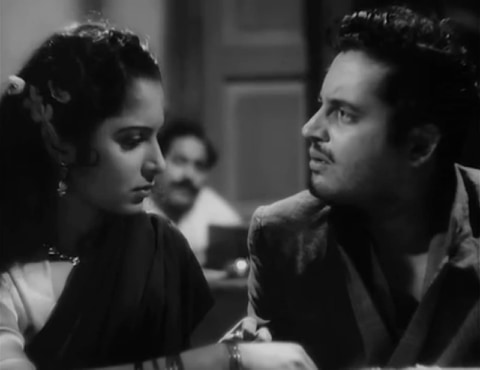
Aap apni kasam kyun deti hain mujhe: Gulab and Vijay unexpectedly develop a bond.
In another song Jaane Wo Kaise Log The Jinke, the fluid camera movement does the job. As Vijay is seen here in the Christ posture for the first time, symbolising that he has been crucified by the hypocritical society, the camera moves towards him for the close-ups and moves towards the guests in a wide shot, taking everyone in a single frame. Here, we are again shown who the victim is, for whom should our sympathy lie and who emerges as the lone warrior.
In the final scene where Vijay’s monologue about the society and denouncing the world to start afresh takes the centre stage in the film, the camera frames Vijay in the centre, making him a God-like or saint-like figure as the white light falls from behind spreading around him. The camera moves slowly towards Vijay and the shot is calmly and composedly converted from a master shot to a close-up.
Pyaasa’s rich black and white photography creates breath taking images in the history of Hindi cinema. The stark contrast in the images create a long lasting effect on the viewers’ minds.
CHARACTERS
VIJAY (GURU DUTT): Guru Dutt played the protagonist in Pyaasa after Dilip Kumar turned it down. Dutt’s charisma as an actor was already well-known through his films like Aar-Paar and Mr. And Mrs. 55, but he was yet to prove his mettle. And he did, thanks to the legendary Dilip Kumar who had some issues of his own due to which, he never did this film.
It is interesting to know that Dilip Kumar did not want Madhubala to essay the role of a prostitute. Also, he had reservations about the prostitute being the ‘heroine’ of the film. But Guru Dutt didn’t bugde. Moreover, Guru Dutt wasn’t able to match the price Dilip Kumar had asked. But he agreed for a low price. Somehow, even though Dilip Kumar agreed to do this film, he never turned up for the shoot and Guru Dutt, who had already shot a few scenes as Vijay, had to jump in again, this time, as the confirmed protagonist of the film.
Pyaasa would have been something else, maybe even a mundane film to look at had Guru Dutt not jumped in at the last moment. He had full command over his performance as a sad and melancholic struggling poet trying to quench his thirst for fame and success. Guru Dutt didn’t look like he was making efforts to portray the character of Vijay, which was to an extent based on Abrar Alvi’s life. Instead, Vijay and Dutt looked like one person. The angst, the melancholy, the helplessness and the shock that the society gives him is perfectly articulated and carved out by Guru Dutt in his best performance ever.
GULAB (WAHEEDA REHMAN): Waheeda Rehman, Guru Dutt’s find, was still a fresh face in the Hindi film industry coming from the south. Although she had made her short debut in Raj Khosla’s C.I.D. (1956) as a gold-hearted vamp, she still had to prove herself as a capable actor. She got this chance in Pyaasa as she was the second lead in the film as a prostitute Gulab who falls for Vijay and his poems. Gulab is again a gold-hearted character. A prostitute who never knew what love is until Vijay came and changed everything in her life forever. The character of Gulab was inspired by the real life prostitute Gulab, whom writer Abrar Alvi met in his life. Interestingly, much of the dialogues of Gulab in Pyaasa are exactly the same words as spoken by the actual Gulab. Waheeda Rehman put all her soul in this character, making it a loveable one. I don’t know if there has been any character like Gulab before Pyaasa – a prostitute who is kind, loving, caring, loves poetry and possesses every quality that normally a traditional heroine of that time used to have. Perhaps this was the same thing which prompted Dilip Kumar to cast Madhubala as Meena and not Gulab for he could not see her in the role of a character which is, unfortunately, looked down upon in our society. Waheeda Rehman surprised everyone with her ‘pakeezagi’ (purity) and elegant acting that is still remembered even after 63 long years.
MEENA (MALA SINHA): The ‘traditional’ heroine of Pyaasa. The one who belongs to a rich family but fell in love with a struggling poet coming from a poor background. She is rich, bold and yes, practical. Mala Sinha’s look in the film is so simple without any heavy make-up and forced English accent. Her acting is so subtle and real that at one time you dislike her for leaving someone like Vijay, but towards the end you realise that there is no wrong in her being practical about life. As discussed above, her practical nature can be seen in the scene where she meets Vijay inside her husband Mr. Ghosh’s office and tells her, “Har insaan ko pyaar ke saath thode bahot daulat ke sahare ki bhi zaroorat hoti hai…”. Meena’s priority was always set. She could love, but she could not fulfil it, she had the capacity to portray her deepest of emotions for someone, but she was well aware that only emotions would not suffice for a better living. We see a different perspective of life through her character. If Meena had taken a decision and chosen her reality, it wasn’t like everything was over for her then. She still had feelings for Vijay. She still cared for him when he came back in her life. She takes charge in the end and with the help of her husband, publishes Vijay’s poems on the request of Gulab.
But, we know that Meena is a practical woman and she shows it towards the end as well. When Vijay denounces the world and tells the audience in the auditorium that he is not Vijay, he is confronted by Meena who suggests her not to kick out all the name, fame and money that he is getting. We see how easily she said those things and how Vijay just listened to her silently. Both have their own set of rules to live by and none can deviate from them.
For Meena, wealth is everything. Fame is everything. She always wants to go up and high in the society (“Main bhool gayi. Mujhe to upar jaana hai”).
MR. GHOSH (REHMAN): The stern and handsome look on Rehman’s face has always been a treat for the silver screen and its lovers. Rehman’s bold and charismatic persona has always made sure he steal the scene, even if he shares the frame with a beautiful and talented actress. Rehman’s Ghosh is a cold-hearted, rich publisher who is possessive about his wife Meena. He doesn’t like Vijay meeting her, most of it is because of the class the latter belongs to. This class struggle makes him enjoy the privilege he has while Vijay is always, at every step, abandoned by the elites and the society in whole. Mr. Ghosh is a rich publisher having friends from elite class. These people, as it is shown in a scene, have much value for materialistic pleasures than human emotions.
For Mr. Ghosh, Vijay’s poems are nothing but just “nausikhiye ki bakwaas”. He tells his secretary that his publishing house publishes the poems of famous and popular poets only and don’t entertain beginner’s rubbish. But the jealous and arrogant husband employs Vijay to dig deeper into the relationship between him and his lost lover Meena.
Of course, in the end though, everything changes after Vijay’s “death”. Vijay suddenly becomes an icon for everyone after his poems are published by Mr. Ghosh on the insistence of Gulab who sells her jewellery for the same. Vijay is suddenly not a beginner anymore. Mr. Ghosh even goes on saying that if Vijay were alive, he would have made a throne for him and placed a crown on his head. However, what happens actually when Vijay is found alive is something that everyone knows. Mr. Ghosh acts as a villain in the film as he even lures Vijay’s brothers and his friend Shyam with money to his side who refuses to recognise his own brother at the asylum.
Calling Mr. Ghosh an arrogant, rich publisher might be a proper adjective, but there is more to his character that comes out on the screen.
ABDUL SATTAR (JOHNNY WALKER): How would you feel if I tell you that Badruddin Jamaluddin Kazi, better known by his stage name Johnny Walker, was to play the role of Shyam (Vijay’s wicked friend) and Shyam was to play the role of Sattar Bhai initially? If it was not for Guru Dutt’s friendship with Johnny Walker, it would’ve been possible. But it is said that Guru Dutt didn’t want to give a negative role to his friend and thus, it was Johnny who became Sattar in the end.
Just like in real life, Sattar the masseur and Vijay were friends in Pyaasa. As Sattar tells his friend in his very first scene that because of the song he had written for him, his business has got set, we gauge the intensity of friendship that the two has. Prior to this scene, we already know which song he is referring to – Sar Jo Tera Chakraaye, sung by none other than Mohammed Rafi. This song is also a testament to the voice of Mohammed Rafi. It shows his versatility as apart from this number, Rafi also has sad and even a romantic duet with Geeta Dutt in the same film.
Coming back to Sattar, we do understand that in old classic films, the presence of a character acting as a comic relief was a must. Johnny Walker, with his composed acting and clean comedy, fulfils what he is asked of. His character of course doesn’t have much screen time but still, he shines in every frame of his. He makes us laugh and at the same time shows how understanding and faithful he is when he listens to his sister Gulab’s plight and also, to his long-time friend Vijay with whom he stays till the very end, being there for him all the time.
Johnny Walker has been working with Guru Dutt since Baazi (1951). Interestingly, it was Guru Dutt only who gave him this name, which was a reference to the brand of Scotch whiskey, when he was inspired by Kazi’s display in the role of a drunkard which he used to perform to amuse the cast of Hulchul (1951), a film produced by veteran writer-director Khwaja Ahmed Abbas and directed by S.K. Ojha. Johnny was an established comedian by then, having last worked with Guru Dutt in the superhit Mr. and Mrs. 55 (1955), he was a trusted choice for Pyaasa. Even then, no one ever reported him of being arrogant or bossy on or off the set. He was a humble person and a true artist by heart. It is no wonder then that playing a faithful friend like Sattar was no big deal for him – a friend that we all need in our life.
SONGS/MUSIC
Pyaasa is the film that is carried by the songs throughout. From the very first frame of the film till its climax, the film is beautified with the songs, to the extent that sometimes it seems as if the film is being played between the songs, not the other way round.
The very first song of the film is not exactly a song, but a few lines written by Sahir Ludhianvi and melodiously sung by Mohammed Rafi. “Ye Hanste Hue Phool” is a short but beautiful number describing the poet’s (read Vijay) fascination and admiration for the nature. But suddenly, with this admiration also comes the realisation that all these things are temporary and even he isn’t able to help them (Main Doon Bhi To Kya Doon Tumhein Ae Shokh Nazaaron, Le De Ke Mere Paas Kuch Aansoo Hain Kuch Aahein). This song is beautifully accompanied by the low but soothing music by S.D. Burman whose music needs no introduction.
“Jaane Kya Tune Kahi” is another gem sung in a beautiful voice by Geeta Dutt. The song is coquettish in nature, but Waheeda aka Gulab is more coquettish. She tries to lure Vijay into her room but Vijay is curious, as the song she is singing is written by the man himself, and he is looking for his lost file. The music here by Burman Da, as he was fondly called, plays an important role. It acts as a melodious filler between the pauses as the song begins, “Jaane Kya Tune Kahi…Jaane Kya Maine Suni…Baat Kuch Ban Hi Gayi”. To some extent, it (melodious filler between the pauses) also reminds me of Bandini’s “Mora Gora Ang Lai Le”, picturised on Nutan, written by Gulzar, sung by Lata Mangeshkar and interestingly, it’s another song composed by S.D. Burman. It is interesting to know that initially Kumkum (who played the character of Gulab’s only friend Juhi) was supposed to feature in this song. But fortunately, Waheeda came on board later, gracing the screen with her elegance and beauty, luring her customer not knowing that the song she so dearly loves belongs to this man only, for whom she would fall eventually.
When Vijay sees Meena for the first time, he is suddenly reminded of his college memories and his romantic relationship with the latter. The poet woos her with his poem and they begin a relationship.
Soon, a group of bicycle riders is seen on the screen with Vijay and Meena riding together on a bicycle as the song “Peechhe Peechhe Duniya Hai Aage Aage Hum” begins. Sung by Geeta Dutt and Mohammed Rafi, this song is a free spirit song telling us about the loving relationship between the leading pair. Guru Dutt is so involved in this song alongwith Mala Sinha, that it seems as if there are two Vijays in Pyaasa. It’s a happy song with its notes at the right place. Composed by S.D. Burman and written by Sahir Ludhianvi, this song is one of the few forgettable or say, less remembered songs of the film.
“Tang Aa Chuke Hain” is a sad, melancholic call from a person who has been rejected by his lover and also by the society. The lyrics go like:
Tang aa chuke hain kashmakash-e-zindagi se hum,
Thukra na dein jahaan ko kahin bedili se hum
This ghazal by Sahir Ludhianvi finds place in Pyaasa in the form of a song with simplified words. A few couplets have been omitted from the original ghazal. What’s interesting to notice is that this song doesn’t have any background music and Rafi sahab’s voice echoes in the silence, highlighting the pain and agony of Vijay and making his message to the world loud and clear. It is said that S.D. Burman, Mohammed Rafi, Guru Dutt and Abrar Alvi met at Dutt’s house for the music session. This same song was to be recorded but Burman da wasn’t well at that time so he didn’t turn up for the meeting. Since Rafi was the only one there who had sense of music, Dutt asked him to give some tune to the song and sing it. It is said that Guru Dutt had this mini tape recorder which he used to tape various voices and songs sometimes. So, he brought the recorder and put it in front of Rafi sahib on the table. Mohammed Rafi, in his beautiful voice, started singing the song. As he completed singing, everyone heard the recording and it was so clear (that was not an ordinary recorder) that Dutt decided to use the same recorded song in the film instead of recording it in the studio.
Rafi’s haunting and melancholic voice in this ‘music less’ song reaches on a higher note towards the end as the poet laments that he has cut off every expectations from everyone (“Lo Aaj Humne Tod Diya Rishta-e-Ummeed, Lo Ab Kabhi Gila Na Karenge Kisi Se Hum”). It’s the magic of Rafi’s voice only that does wonders taking all the responsibility on itself.
Another number is an amusing song sung by who else but Mohammed Rafi, picturised on our masseuse Abdul Sattar played by Johnny Walker. “Sar Jo Tera Chakraaye” is a song that has become so popular that it has also been used in various TV commercials. The song is the proof that Rafi could sing any kind of song, no matter the range. The song’s tune is based on a song from the 1958 British film Harry Black. SD Burman was initially reluctant to use a Western tune for his song but later obliged, infusing his own elements into the song to an extent that the original composer couldn’t recognise his own tune.
Sar Jo Tera Chakraye, the song about massage, works as a relieving massage to the viewers and to a rather pessimistic film. It is the only funny soundtrack in the film picturised on Johnny Walker, both working as comic relief.
“Aaj Sajan Mohe Ang Laga Lo” is a melancholic yet hopeful song in Pyaasa. Written by Sahir Ludhianvi and sung by Geeta Dutt, the song is actually a kirtan – a Bengali devotional song expressing longing and desire. Though it is being sung by an aescetic woman, the lyrics also tell the anguish and love that Gulab is feeling for her beloved struggling poet Vijay. This song is unfortunately the less popular song of all. Calling it forgettable would be inappropriate though.
“Hum Aapki Aankhon Mein” is the only romantic song of Pyaasa. Guru Dutt never wanted this song in the film but on the insistence of the distributors, this song was shot and included in the final cut. Hum Aapki Aankhon Mein is sung by Geeta Dutt and Mohd Rafi sahab, written by Sahir and composed by SD Burman. This song didn’t even exist in the first cut of the film because in a melancholic and serious film like Pyaasa there was no place for romance. But since distributors asked for one, Guru Dutt obliged and hence this song. Hum Aapki Aankhon Mein also showcases the dance talent of Guru Dutt. As a trained dancer, it was not difficult for him to match the steps with a fresh face like Mala Sinha. The picturisation of this song can also be dubbed as a tribute to Raj Kapoor’s Awaara (1951) by Guru Dutt who was a great admirer of the former’s work.
The male voice in all the songs were of Mohammed Rafi sahab. But there was one song where Hemant Kumar became the voice of Guru Dutt, something which Dutt disliked initially for the obvious reason, but later gave up when Geeta Dutt, and according to some sources, SD Burman insisted.
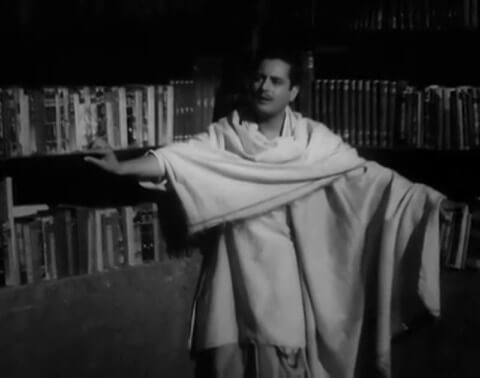
Bichhad Gaya Har Saathi Dekar Pal Do Pal Ka Saath: Vijay in anguish of his lost love.
“Jaane Wo Kaise Log The Jinke…” is that one song where you don’t listen to the enchanting voice of Mohammed Rafi gracing your ears, but a haunting yet beautiful voice of Hemant Kumar. Guru Dutt never wanted another male voice other than Rafi sahab’s because his voice had been used in all the songs of the film. But SD Burman refused and suggested Hemant Kumar due to the situation and tone of the song. After much heated argument, Dutt finally gave up.
Another incident is that once Guru Dutt, along with his wife Geeta Dutt and writer Abrar Alvi were going somewhere in a car when Guru Dutt played the recorded song on his recorder and asked for the opinion. When Geeta Dutt opined that Hemant Kumar’s voice would suit more than that of Rafi, Dutt didn’t say anything after that. His silence, though, said a lot.
“Jaane Wo Kaise Log The Jinke…” is a beautiful and painful song of Pyaasa. Depicting the anguish of the lost love and the unfortunate companionship of sorrows, this song tells the misery of the protagonist in a brilliant fashion, as if he has accepted his fate by embracing his pains. Penned by Sahir Ludhianvi and composed by SD Burman, “Jaane Wo Kaise Log The Jinke…” is a beautiful poem for the heartbroken and the troubled people.
Pyaasa boasts of social commentary on class and poverty issue through dialogues and even through songs. “Jinhein Naaz Hai Hind Par Wo Kahaan Hain?” is one such song which highlights the immorality and lack of human values and empathy in men who are just greedy and seek lust. Subtle attacks on patriarchal mindset are also visible in the lyrics as Sahir goes on to write about the presence of men of all age groups in the brothel. The men whose lust knows no bound. Prior to this song, we see Vijay is uncomfortable after seeing a mother of a baby dancing as she is forced to do so. The madam doesn’t even let her attend to the weeping baby, a heart-wrenching scene inspired by a real event that occurred with Guru Dutt and Abrar Alvi. “Jinhein Naaz Hai…” is above all, a song of cry as the poet seeks help from the ones proud of the nation. He asks the ones governing the nation to just have a look at the plight and condition of the women. Their sick faces don’t melt the hearts of the cruel men who just see them through lustful eyes and think of them as mere commodities made to fulfil their desires.
This song is also a cry for help. “Madad chaahti hai ye hawwa ki beti…”, these lines fall perfectly in that category. It seems like a helpless effort to cry for help infront of those in charge. If such a poem/song is inked by Sahir Ludhianvi, then don’t be surprised. Sahir Ludhianvi was not just a romantic poet, but much of his poetry was also about the marginalised and oppressed section of the society. One of his famous poems “Taj Mahal” criticised the beautiful monument and the emperor Shah Jahan who built it.
Sahir used his poetry to the best of use in Pyaasa. His poem was used in this film with little amendments. It is also said that Sahir wrote this nazm (poem) in reply to then Prime Minister who went on saying “Humein apne Hind par naaz hai” (We are proud of our nation). Pyaasa flourished Sahir’s poetry and it won’t be wrong to say that Pyaasa would be nothing without Sahir. This film is as much as his as it is Guru Dutt’s.
In the end, when everything collapses for Vijay; when he is devastated by the betrayal, hypocrisy and greed everywhere, he denounces this world. As Mr. Ghosh goes on saying that the world which earlier abandoned Vijay, the same world now wants to place a crown on his head and offer him a throne, Vijay replies back in fashion, standing in his yet again Christ-like posture as he is crucified once again, saying, “Ye Duniya Agar Mil Bhi Jaaye To Kya Hai.”
This haunting song is sung by Vijay’s voice Mohammed Rafi. Penned by Sahir Ludhianvi, the song denounces the world which is fake, hypocrite and greedy in its need. During the shoot, Abrar Alvi wasn’t present due to his surgery. Guru Dutt had to shoot the final auditorium scene but due to the unavailability of his film’s writer, he decided to shoot the song instead. When Abrar returned back, he was impressed by the picturisation of the song, but was unsatisfied by the words “mahal” (palace) and “takht” (throne). He argued that the film is not about ancient times and the audience would get confused and don’t like it. Guru Dutt said that it can’t be removed because it has been shot perfectly. So, in order for it to make sense, Abrar changed the dialogues of Rehman (Mr. Ghosh) and added the lines where he mentions about throne, crown and palace.
Mohd. Rafi’s voice adds wonder to Vijay’s lament. Vijay has nothing to lose now. He is registering his dissent and despise towards such society clearly and loudly. The song reaches another high towards the end. Rafi’s range is noticeable and worthy of appreciation here. He reaches to a high-point and sings “Jala do ise phoonk daalo ye duniya”, making it loud and clear what protagonist’s anguish and anger is about. Rafi’s genius lies in the fact that he moulded his voice according to the different actors or say, characters he sang for. And this song towards the very end is a proof of that. Pyaasa couldn’t have got a better ending than this.
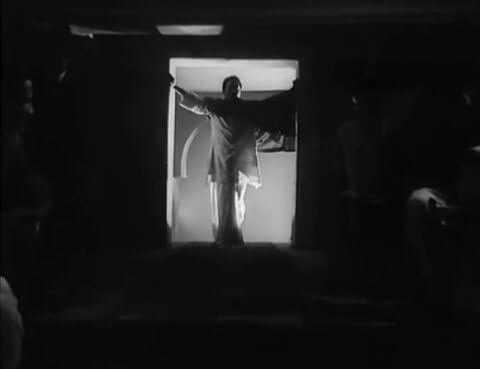
Ye Duniya Agar Mil Bhi Jaaye To Kya Hai?: Crucified, Vijay denounces the world in fashion.
CLOSING THE CURTAIN
Pyaasa is Guru Dutt’s ‘thirsty’ poem on celluloid. It is a film with Guru Dutt written all over it. Right from producing it to acting in it, a decision which he took late into the production, Pyaasa boasts of beautiful frames of Guru Dutt projecting his pain, hopelessness and anger. The film is also carried over on the shoulders of its memorable and ageless songs penned by the maestro Sahir Ludhianvi whose poetry enjoyed complete nourishment through this, and composed by the legendary S.D. Burman whose fine tunes gave melody to the golden words. Geeta Dutt, Mohammed Rafi and Hemant Kumar added life to these words through their terrific voices. Hemant Kumar was given just one song and he did full justice to it. Direction, cinematography and editing are top-notch and together all of it make Pyaasa what it is today – a timeless classic.
You may also like ; Bulbul Can Sing 2018 Review | A Meditative Masterpiece
In dark times like these, a film like Pyaasa is a wake up call to everyone. Pyaasa leaves us with many questions and with a few answers or maybe, none. It’s upto us to find those answers. Have we evolved as a society? Do we still see our society in a film that was released 63 years ago? Does Pyaasa still feel relevant? Vijay denounces the world which is full of greed, lust, disloyalty and hypocrisy. And he does that with courage. Pyaasa ends on a note where the film stays in the viewer’s mind even after the end credits end, along with a very important question – “Ye Duniya Agar Mil Bhi Jaaye To Kya Hai? (What even if I get the enough of this world?)”


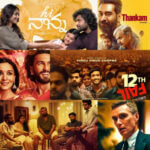





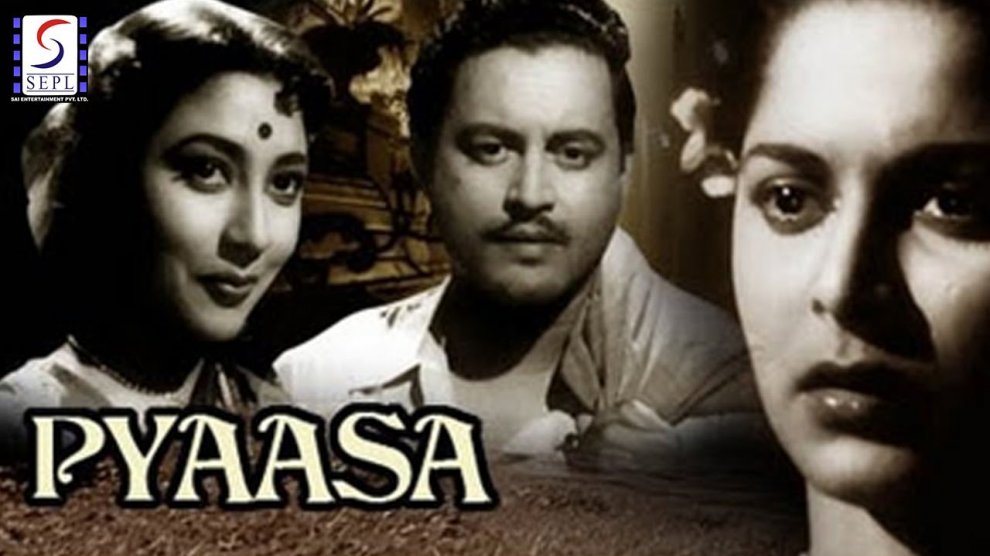






Add Comment